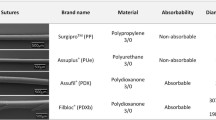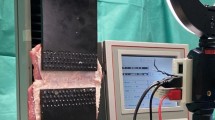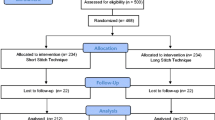Summary
Every suture technique in surgery aims at connecting tissue structures until stable scar formation has developed. Although the negative effects of high suture tension on the mechanical properties of the developing scar are well known, the applied suture tension has not been standardized and depends on the surgeon's experience. In this study the effects of low suture tension on laparotomy closure were studied in rats and an incisional hernia model was developed. Median laparotomies were closed by running suture using Foley-catheters with a diameter of 2.4, 4.8 and 7.2 mm as distance holders. In another group, an abdominal wall defect of 2 cm diameter was created and covered internally by larger omentum. After 28 days laparotomies closed using a distance holder with diameter of 2.4 and 4.8 mm had healed without developing fascial dehiscence or incisional hernia. With 7.2 mm catheters all animals developed a ruptured abdomen. All animals with abdominal wall defects developed incisional hernias with stable hernial sacs without significant inflammatory reaction.
Laparotomy closure intentionally performed with a surplus of suture material of up to 21% per stitch in a 4 cm incision does not result in a disturbance of wound healing or hernia formation. Creating an abdominal wall defect with an internal covering of great omentum in rats reliably results in incisional hernia formation closely resembling that found in humans. These results underline the necessity to further determine values for tissue-specific suture tension experimentally.
Similar content being viewed by others
References
Aberg C (1976) Change of strength of aponeurotic tissue enclosed in the suture during initial healing period. Acta Chir Scand 142: 429–432
Adamson RJ, Musco F, Enquist IF (1966) The chemical dimension of a healing incision. Surg Gynec Obstet 123: 515–521
Blomstedt AH, Bertil S, Jacobsson I (1977) Experiences with polyglactin 910 (Vicryl) in general surgery. Acta Chir Scand 143: 259–263
Flament JD, Rives J (1998) Major incisional hernia. In: Chevrel JP (ed) Hernias and surgery of the abdominal wall. Springer, Paris Berlin Heidelberg New York, pp 128–156
Högström H, Haglund U, Zederfeldt B (1985) Suture technique and early breaking strength of intestinal anastomoses and laparotomy wounds. Acta Chir Scand 151: 441–443
Högström H, Haglund U, Zederfeldt B (1990) Tension leads to increased neutrophil accumulation and decreased laparotomy strength. Surgery 107: 215–219
Israelsson LA (1998) The surgeon as a risk factor for complications of midline incisions. Eur J Surg 164: 353–358
Israelsson LA (1999) Continuous closure of laparotomy incisions. Aspects on Suture Technique. In: Schumpelick V; Kingsnorth AN (eds) Incisional Hernia. Springer, Berlin Heidelberg New York, pp 246–252
Jenkins TPN (1976) The burst abdominal wound. A mechanical approach. Br J Surg 63: 873–876
Klinge U, Prescher A, Klosterhalfen B, Schumpelick V (1997) Development and pathophysiology of abdominal wall defects. Chirurg 68: 293–303
Leaper DJ (1983) Angiography as an index of healing in experimental laparotomy wounds and colonic anastomoses. Ann Royal Coll Surg 65: 20–23
Leaper DJ (1982) A method for the study of the vasculature of the abdominal wall and gastrointestinal tract in experimental animals. Microcirculation 2: 35–40
Marmon LM, Vinocour CD, Standiford SB, Wagner CW et al (1985) Evaluation of absorbable polyglycolic acid mesh as a wound support. J Ped Surg 20: 737–741
Martyak SN, Curtis LE (1976) Abdominal incisions and closure. Am J Surg 131: 476–480
Rath AM, Chevrel JP (1998) The healing of laparotomies: review of the literature, part I. Physiologic and pathologic aspects. Hernia 2: 145–149
Sanders RJ, di Clementi D, Ireland K (1977) Principles of abdominal wound closure. Arch Surg 112: 1184–1188
Stelzner F (1988) Theory and practice of continuous laparotomy suture (abdominal wound dehiscence and incisional hernia). Chirurg 59: 654–660
Stone IK, v. Fraunhofer JA, Masterson BJ (1986) The biomechanical effects of tight suture closure upon fascia. Surg Gynecol Obstet 163: 448–452
Trimbos JB, van-Rooij J (1993) Amount of suture material needed for continuous or interrupted wound closure: an experimental study. Eur J Surg 159: 141–143
Wadström J, Gerdin B (1990) Closure of the abdominal wall; how and why ? Clinical review. Acta Chir Scand 156(1): 75–82
Author information
Authors and Affiliations
Rights and permissions
About this article
Cite this article
Höer, J., Anurow, M., Titkova, S. et al. Loose fascial closure and fascial defects: effects on laparotomy healing in rats. Hernia 4, 67–71 (2000). https://doi.org/10.1007/BF02353745
Received:
Accepted:
Issue Date:
DOI: https://doi.org/10.1007/BF02353745




